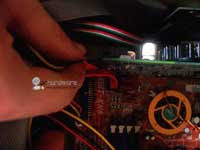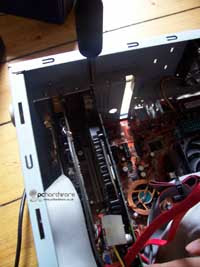Flashing and Unlocking are two popular ways to gain performance out of a video card, without technically overclocking.
Flashing refers to using the BIOS of another card, based on the same core and design specs, to "override" the original BIOS, thus effectively making it a higher model card; however, 'flashing' can be difficult, and sometimes a bad flash can be irreversible. Sometimes stand-alone software to modify the BIOS files can be found, i.e. NiBiTor, (GeForce 6/7 series are well regarded in this aspect). It is not necessary to acquire a BIOS file from a better model video card (although it should be said that the card which BIOS is to be used should be compatible, i.e. the same model base, design and/or manufacture process, revisions etc.). For example, video cards with 3D accelerators (the vast majority of today's market) have two voltage and speed settings - one for 2D and one for 3D - but were designed to operate with three voltage stages, the third being somewhere in the middle of the aforementioned two, serving as a fallback when the card overheats or as a middle-stage when going from 2D to 3D operation mode. Therefore, it could be wise to set this middle-stage prior to "serious" overclocking, specifically because of this fallback ability - the card can drop down to this speed, reducing by a few (or sometimes a few dozen, depending on the setting) percent of its efficiency and cool down, without dropping out of 3D mode (and afterwards return to the desired full-speed clock and voltage settings).
Some cards also have certain abilities not directly connected with overclocking. For example, NVIDIA's GeForce 6600GT (AGP flavor) features a temperature monitor (used internally by the card), which is invisible to the user in the 'vanilla' version of the card's BIOS. Modifying the BIOS (taking it out, reprogramming the values and flashing it back in) can allow a 'Temperature' tab to become visible in the card driver's advanced menu.
Unlocking refers to enabling extra pipelines and/or pixel shaders. The 6800LE, the 6800GS and 6800 (AGP models only) and Radeon X800 Pro VIVO were some of the first cards to benefit from unlocking. While these models have either 8 or 12 pipes enabled, they share the same 16x6 GPU core as a 6800GT or Ultra, but may not have passed inspection when all their pipelines and shaders were unlocked. In more recent generations, both ATI and Nvidia have laser cut pipelines to prevent this practice.[citation needed].
Graphics cards in the same series all share a processor based on the same architecture. For example, all 7 series cards have the 7 series GPU architecture. The differences between cards are the number of transistors in the processor and the speed at which it is clocked. A higher number in the series will have a higher transistor count, for example an 8800 will have more transistors than an 8600. A processor with a higher clock speed is one that has been thoroughly tested at that speed, with the output being checked by ATI or NVIDIA to ensure that there are no silent errors. These are small errors which would go undetected without examining the output for them. Lower models of the processor have not been certified at higher speeds, but can be run at a higher speed than specified.
It is important to remember that while pipeline unlocking sounds very promising, there is absolutely no way of determining if these 'unlocked' pipelines will operate without errors, or at all (this information is solely at the manufacturer's discretion). In a worst-case scenario, the card may not start up ever again, resulting in a 'dead' piece of equipment. It is possible to revert to the card's previous settings, but it involves manual BIOS flashing using special tools and an identical but original BIOS chip.

















